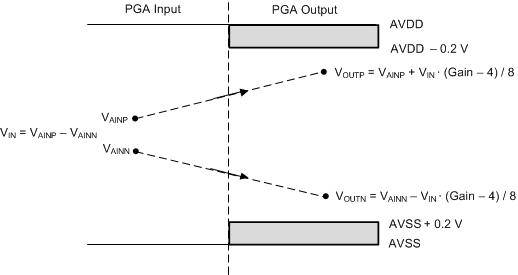ZHCSHD5A January 2018 – October 2018 ADS112U04
PRODUCTION DATA.
- 1 特性
- 2 应用
- 3 说明
- 4 修订历史记录
- 5 Pin Configuration and Functions
- 6 Specifications
- 7 Parameter Measurement Information
-
8 Detailed Description
- 8.1 Overview
- 8.2 Functional Block Diagram
- 8.3
Feature Description
- 8.3.1 Multiplexer
- 8.3.2 Low-Noise Programmable Gain Stage
- 8.3.3 Voltage Reference
- 8.3.4 Modulator and Internal Oscillator
- 8.3.5 Digital Filter
- 8.3.6 Conversion Times
- 8.3.7 Excitation Current Sources
- 8.3.8 Sensor Detection
- 8.3.9 System Monitor
- 8.3.10 Temperature Sensor
- 8.3.11 Offset Calibration
- 8.3.12 Conversion Data Counter
- 8.3.13 Data Integrity
- 8.3.14 General-Purpose Digital Inputs/Outputs
- 8.4 Device Functional Modes
- 8.5 Programming
- 8.6
Register Map
- 8.6.1 Configuration Registers
- 8.6.2
Register Descriptions
- 8.6.2.1 Configuration Register 0 (address = 00h) [reset = 00h]
- 8.6.2.2 Configuration Register 1 (address = 01h) [reset = 00h]
- 8.6.2.3 Configuration Register 2 (address = 02h) [reset = 00h]
- 8.6.2.4 Configuration Register 3 (address = 03h) [reset = 00h]
- 8.6.2.5 Configuration Register 4 (address = 04h) [reset = 00h]
- 9 Application and Implementation
- 10Power Supply Recommendations
- 11Layout
- 12器件和文档支持
- 13机械、封装和可订购信息
封装选项
机械数据 (封装 | 引脚)
散热焊盘机械数据 (封装 | 引脚)
- RTE|16
订购信息
8.3.2.1 PGA Input Voltage Requirements
As with many amplifiers, the PGA has an absolute input voltage range requirement that cannot be exceeded. The maximum and minimum absolute input voltages are limited by the voltage swing capability of the PGA output. The specified minimum and maximum absolute input voltages (VAINP and VAINN) depend on the PGA gain, the maximum differential input voltage (VINMAX), and the tolerance of the analog power-supply voltages (AVDD and AVSS). Because gain on the ADS112U04 is implemented by both the PGA and a switched-capacitor gain circuit, there are two formulas that define the absolute input voltages. Use Equation 6 when the device gain is configured to less than or equal to 4. Use Equation 7 when the device gain is greater than 4. Use the maximum differential input voltage expected in the application for VINMAX.
Figure 47 graphically shows the relationship between the PGA input voltages to the PGA output voltages for gains larger than 4. The PGA output voltages (VOUTP, VOUTN) depend on the PGA gain and the differential input voltage magnitudes. For linear operation, the PGA output voltages must not exceed AVDD – 0.2 V or AVSS + 0.2 V. Figure 47 depicts an example of a positive differential input voltage that results in a positive differential output voltage.
 Figure 47. PGA Input/Output Voltage Relationship
Figure 47. PGA Input/Output Voltage Relationship